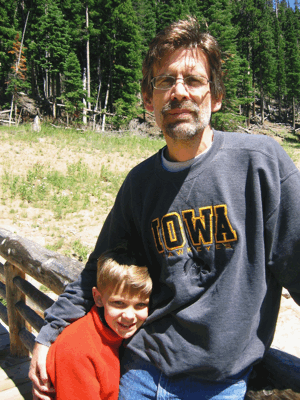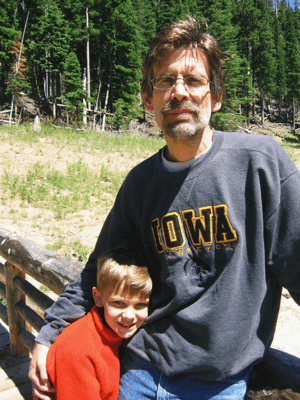Bird Wonder
Air Date: Week of April 30, 2010
 |
At this time of year, many migratory birds have been returning to their North American homes. But with insects and seed not yet plentiful, the birds have been flocking to backyard birdfeeders. Commentator Tom Montgomery-Fate has been watching these recent arrivals with his young son.
Transcript
YOUNG: Some birders travel great distances to see rare species, filling out impressive life lists of species. But not commentator Tom Montgomery-Fate. Tom and his boy let the birds travel to them, as their migrating friends return to the Midwest.
MONTGOMERY-FATE: My eight-year-old son Bennett and I like to watch birds at our back yard feeders. We have a pair of binoculars, a field guide, and a little journal to keep track of what we see. That’s the point for me—not seeking out rare birds or dozens of different species—but just learning to see the ordinary birds that live here, in suburban Chicago.

Four house sparrows are scratching in the seed when a male cardinal drops in out of nowhere like a shiny winged fire engine pulling up to a working class bar. As the chattering sparrows makes way for the noble bird I tell Bennett how the Cardinal got its name. Due to its stiff triangular crest and bright red feathers the male cardinal was named after its Catholic counterpart in the church. We muse about whether the naming has anything to do with its behavior. Does the bird have an elevated sense of morality? When he flies away I imagine he’s off to address a flock of sinful starlings—to hold a chirpy mass in some huge lilac bush with a communion of mulberry juice and crickets. But instead he flies to his mate, who is singing from a nearby elm branch. He feeds her the seed he has brought her.
I don’t tell Bennett that Cardinals are single and celibate. Nor how amused I am by the clutch of red finches that have now gathered around the feeder. Whenever the Cardinal returns to the feeder they all quickly drop to the ground to gobble up the tiny grains that he scatters on them in an odd sort of baptism. “Look, he’s kicking the food to them,” Bennett says. “Yeah,” I say. “And they seem thankful.”
Later, two robins, a nuthatch, and a few sparrows are all having a quiet snack when a raucous gang of grackles arrive, they crash the birdfeeders like drunk conventioneers who can’t believe they’ve stumbled onto a free smorgasbord. It takes a minute for Bennett to figure out that the birds are grackles and not starlings. The guide helps: grackles walk on the ground. But starlings don’t; like robins, they hop. We both like identifying the birds by behavior rather than color—seeing more than the most obvious markers.
“I count twenty-four,” Bennett says. He watches the birds intently. We try to distinguish the males from females and the juvenile birds from the mature birds. It’s difficult, but the longer we watch the more we see.
Links
Living on Earth wants to hear from you!
Living on Earth
62 Calef Highway, Suite 212
Lee, NH 03861
Telephone: 617-287-4121
E-mail: comments@loe.org
Newsletter [Click here]
Donate to Living on Earth!
Living on Earth is an independent media program and relies entirely on contributions from listeners and institutions supporting public service. Please donate now to preserve an independent environmental voice.
NewsletterLiving on Earth offers a weekly delivery of the show's rundown to your mailbox. Sign up for our newsletter today!
 Sailors For The Sea: Be the change you want to sea.
Sailors For The Sea: Be the change you want to sea.
 The Grantham Foundation for the Protection of the Environment: Committed to protecting and improving the health of the global environment.
The Grantham Foundation for the Protection of the Environment: Committed to protecting and improving the health of the global environment.
 Contribute to Living on Earth and receive, as our gift to you, an archival print of one of Mark Seth Lender's extraordinary wildlife photographs. Follow the link to see Mark's current collection of photographs.
Contribute to Living on Earth and receive, as our gift to you, an archival print of one of Mark Seth Lender's extraordinary wildlife photographs. Follow the link to see Mark's current collection of photographs.
 Buy a signed copy of Mark Seth Lender's book Smeagull the Seagull & support Living on Earth
Buy a signed copy of Mark Seth Lender's book Smeagull the Seagull & support Living on Earth

